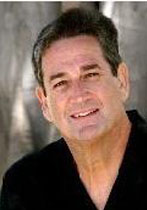By Rabbi Ben Kamin

SAN DIEGO — For some time now, I have clandestinely carried a ball club in my memory—a club, a city and a patch of old ball yard. Time, faded careers and even the emergence of third-generation retro-ball fields named with corporate icons have failed to tarnish the image of Crosley Field and the grand old Cincinnati Reds of the 1960s and 1970s.
The upstart National League contenders of this year, riding in first place in their division, recall those heady days when the Reds evolved from the heavy-shouldered clan of patriarchal lumberjacks who faced the Yankees in the 1961 World Series into the machine-like barons of 1970s’ Riverfront Stadium AstroTurf. Arriving in Cincinnati in time for the third-place 1962 “Redlegs,” I saw, through boyhood eyes, the bulging biceps of the boisterous Gordy Coleman, the moody gait of Frank Robinson, and the skinny body language of a shortstop named Chico Cardenas
In those days, when presidents were distant, regal figures seen on grainy screens and who were proportionately heroic to the distance, you could see a ball club up close–at Crosley, Wrigley or Forbes Fields. My adult daughters don’t ask for a Blackberry and expect fruit; they watch television on cellular phones, and remain nonplussed to this day by my reports of a strip of green grass called Crosley Field. It’s too bad Brangelina doesn’t sweat; I saw Frankie Robinson overheat with feeling across the right fields of my summer adventures.
Indeed, Cincinnati gave up a lot of lore and personality when, in 1970, it razed Crosley Field and its old-fashioned dugouts and its legendary right-field bleacher section. My buddy Steve and I put down a dollar each and walked across peanut-strewn, suds-stained benches into the eye-filling, proximate, wooden realm of America’s solar ritual. It was not so long ago: the players were the giants, not their salaries.
We would, in fact, actually see Robinson twitch and sweat in the daytime mugginess of that “Sun Deck;” the same section converted seamlessly in the evening to the soft and inviting “Moon Deck.”
Don Blasingame gave way reluctantly at second base to a brash hometown crew-cut called Pete Rose; an Oklahoma comet named Johnny Bench replaced Johnny Edwards behind the plate. Bench caused a near-scandal in the old beer town when, after his stellar 1970 season, he had the audacity to ask for an unheard-of salary of $500,000 – over three years. The summer gods rewarded him with a lackluster 1971 campaign, as the Reds were almost as bad again as the Indians up in bronchial, smoke-stacked, weary Cleveland.
Meanwhile, “The Big Red Machine” had transferred into the somewhat sterile, cookie-cutter ’70s-style new stadium with carpeting. No question that this was a necessary element in Cincinnati’s economic revival. A shiny new downtown grew up around the round landmark that was indistinguishable from the same cereal bowls in Atlanta, Pittsburgh and Philadelphia. Suddenly, Steve and I were forcefully removed from the $1 kingdom and were now denied intimacy with big-league rosin bags and pitching rubbers.
When I saw journeyman relief pitcher Jack Aker come in there one day for the “cousin Cubs” and strike out the heart of the Cincinnati order, Joe Morgan, Bench and Tony Perez, I had no idea what this looked like on Aker’s face. Serendipitously, I was able to ask Aker about it years later:
“You should have seen me sweating,” he replied.
I should have, indeed. When my chums and I had stolen down by city bus to Crosley Field, the Reds weren’t kings yet, but we were in the ball yard. My hometown needed Riverfront Stadium, and now Great American Ball Park, just as surely as Steve and I needed to grow up. But when the Reds won an array of championships in the 1970s, a few of us refused to give up our recollections of the summer days when a perch in the bleachers still meant a spot in destiny.
These days, with steroid crises and cyber connections to further de-regionalize both America and its game, some of us former Cincinnati kids find our hearts panting and minds racing back to those humid nights when—if we couldn’t catch the bus to Crosley—we would sit by our radios, adjusting dials again and again, and take in Waite Hoyt’s lyrical accounts of the action. Words, tales, summer breezes and an AM radio jumping with lightning-ignited static would send us the stories of a Wally Post at-bat, a Vada Pinson steal or a Bob Purkey two-hitter.
I still listen, granted on my high-speed access computer, late at night to the one-time lords of the Cincinnati summers. Yes, it’s late at night, when the heart reflects, and – although Ken Griffey Jr. and an agent-driven salary long replaced Vada’s exuberant, Spanish tones – there is a special baseball childhood to bring on a sympathetic, nocturnal rebroadcast from an ethereal ball yard that was named Crosley.
*
Rabbi Kamin is a freelance writer based in San Diego. He may be contacted at ben.kamin@sdjewishworld.com